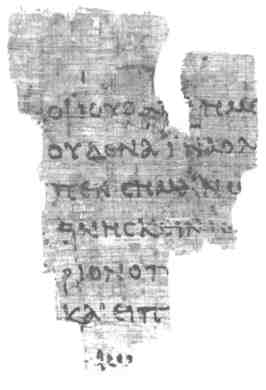
Papyrus p52 of John 18:31-33 from before 150 A.D.
By permission of the John Rylands University Library, Manchester.
In following the historical development of the Gospel-New Testament from the time Jesus started preaching until John wrote the last Gospel account between 80 and 95 AD, we have found no evidence for alteration or falsification of the Bible.
Photograph 1 of Part A in this chapter and Photograph 5 in this part show papyrus manuscripts dating from 200 AD. These two documents alone represent almost 40% of our present Gospel-New Testament, and where applicable, the English, French and Arabic New Testaments which we use every day are translated from these Greek papyri.
That leaves the time from 90 AD to 200 AD as a period when theoretically some change might have taken place in the Gospel-New Testament, so we shall now turn our attention to this period.
Clement of Rome---96 AD
In Part A of this chapter we saw that I Corinthians was written in 55 AD. Forty years later in about 96 AD, a man named Clement, a bishop in Rome, wrote a letter to the church at Corinth just as Paul had done. In that letter he writes,
"Read your letter from the blessed Apostle Paul again."
What letter is Clement referring to? He is referring to I Corinthians, the very letter in which the Doctrinal Gospel was written down for the first time, and he quotes from I Corinthians 15:20 saying,
"He (God) has made Jesus Christ the first-fruits by raising him from the dead".
In addition to other quotations from I Corinthians, he paraphrases or quotes from the Judeo-Christian Gospel of Matthew, and five other New Testament books: I Peter, James, Hebrews, Paul's letters to the Romans, and Ephesians.
It is natural that he would know about the letter to the Romans since it had been written to Clement's own church in Rome. But the other letters had been written to churches in Greece and what is now Turkey. This shows that they were quickly circulated among the early Christians, just as the new verses and Suras of the Qur'an were quickly circulated among the early Muslims.
Moreover, we can see from the above tiny quotation that there was no change in the Doctrinal Gospel between the time when Paul wrote it down in 55 AD and the moment when Clement quoted it 40 years later.
Polycarp's letter to Philippi---107 AD
Polycarp was born in 69 or 70 AD in Asia (now Turkey). He heard the Gospel from the Apostle John who lived in Turkey in his old age, and according to Irenaeus, Polycarp "had had familiar intercourse with many who had seen Christ." In his later years he became Bishop of the church in Smyrna, about 40 miles north of Ephesus. Smyrna still exists today as the town of Izmir, Turkey with about 200,000 people.
Sometime around 107 AD, he wrote a letter to the church at Philippi---a church started by Paul in 49 or 50 AD.
In his letter he refers to "the apostles who brought us the Gospel, and the prophets who foretold the coming of the Lord (the Messiah)". At least three times he mentions Paul by name, as well as stressing the fact that Paul had preached to the Philippians and then written to them. He calls Paul's letter to the Ephesians "scripture"---the same title used for the Torah of Moses---as we see in the following quotation:
"I have no doubt you are well versed in Holy Scripture...it says there, `Do not be angry to the point of sin; do not let the sun go down on your indignation'. [quoted from Ephesians 4:26] The happy man is he who keeps this in mind...May the God and Father of our Lord Jesus Christ, and the eternal High Priest Jesus Christ himself, the Son of God, help you to grow in faith and truth.
"In him (Jesus the Messiah), endurance went so far as to face even death for our sins...Though you never saw him for yourselves, yet you believed in him...well knowing that it is by grace you are saved, not of your own doing. [quoted from Ephesians 2:8]
The sections in boldfaced type show that he firmly believed in the Doctrinal Gospel, and in this short letter of seven pages, he quotes from the Gospel according to Matthew, Acts, Romans, I Corinthians, Galatians, II Thessalonians, I Timothy, I Peter, and I John, as well as Ephesians, for a total of 10 of the 27 New Testament books.
These ten books, originating in places as far apart as Palestine, Turkey, Greece, and Rome, were well-known to Polycarp only ten or 15 years after the death of John the Apostle, again demonstrating the early and wide dissemination of the New Testament scriptures.
The last person from whom we shall quote is another Roman historian. Pliny the Younger was Governor of Bithynia (Northern Turkey) in 112 AD, and wrote letters to the Emperor Trajan asking for advice. He complained that hardly anyone was sacrificing to the Roman Gods (idols), and the temples had fallen into disrepair because of the Christians. He began to kill the Christians if they would not sacrifice to the statues of the Emperor. He attempted to make them "curse Christ", because he was told that it was impossible to make a genuine Christian do this.
In the same letter, he says of the people being tried:
"They affirmed, however, that the whole of their guilt, or their error, was, that they were in the habit of meeting on a certain fixed day before it was light, when they sang in alternate verse a hymn to Christ as to a God, and bound themselves to a solemn oath, not to any wicked deeds, but never to commit any fraud, theft, adultery, never to falsify their word, not to deny a trust when they should be called upon to deliver it up."
Again, from the boldfaced words in the testimony of this pagan worshiper of idols, it is clear that the Christians were declaring their belief in the Doctrinal Gospel, and even dying for it.
Papyrus Fragment of John's Gospel from 135 AD
The earliest papyrus copy of any New Testament book is a fragment of the Gospel of John at the John Rylands Library in Manchester, England with the number p52. As you can see from Photograph 4, it is very small and contains a few words from John 18:31-33 on one side and a few more words from verses 37-38 on the other.
However, it is very important because of the date of writing and the place where it was found. Dr. Bruce M. Metzger, Professor of new Testament Language and Literature at Princeton Theological Seminary discusses this in his book The Text of the New Testament. He writes,
"On the basis of the style of the script, C. H. Roberts (who discovered it) dated the fragment in the first half of the second century. Though not all scholars are convinced that it can be dated within so narrow a range, such eminent palaeographers as Sir Frederic G. Kenyon, W. Schubar, Sir Harold I. Bell, Adolf Deissmann, Ulrich Wilcken, and W. H. P. Hatch have expressed themselves as being in agreement with Roberts' judgement.
"Although the extent of the verses preserved is so slight, in one respect this tiny scrap of papyrus (p52) possesses quite as much evidential value as would the complete codex (book)...(For it) proves the existence and use of the Fourth Gospel (of John) during the first half of the second century in a provincial town along the Nile, far removed from its traditional place of composition (Ephesus in Ancient Turkey)."

|
|
|
Photograph 4--
Papyrus p52 of John 18:31-33 from before 150 A.D. By permission of the John Rylands University Library, Manchester. |
|
Therefore, if someone did wish to change either the Written Gospel or the Doctrinal Gospel, how would he go about altering the words in all these copies, and the knowledge of the words in all those minds and hearts?
The last two papyrus manuscripts which we want to discuss, are dated around 200 AD. The first one, numbered p75 is now in the Bodmer Library of World Literature at Cologny, a suburb of Geneva, Switzerland. It originally contained Luke and John on 144 pages, of which 102 pages, or about 70%, remain. It is the oldest known copy of the Gospel according to Luke, and one of the earliest copies of the Gospel according to John.
Of great importance to any study of Christian doctrine is the fact that the middle of the codex with the last three chapters of Luke and the first 13 chapters of John are intact. The first chapter of John includes the preexistence of the divine "Word" which became flesh. The last three chapters of Luke include Jesus' death on the cross and three of his resurrection appearances. Photograph 5 of Luke 24:31-50 includes these three appearances---the first to two disciples on the road to Emmaus---the second to Peter---and the third to all the disciples except Thomas. Photograph 7 in Chapter I of Section Six shows a picture of John 14:16 from this same papyrus.
We have already seen a picture of the second manuscript, designated p46, in Photograph 1 in Part A of this chapter. It comprises eighty-six leaves, or 75%, of a papyrus codex originally made up of 114 leaves. Presently in the Chester Beatty Museum in Dublin, Ireland, it contains ten epistles of Paul in the following order: Romans, Hebrews, I and II Corinthians, Ephesians, Galatians, Philippians, Colossians, and I and II Thessalonians. As might be expected in an ancient book, part of the beginning and end are missing. However, I Corinthians, which was written in 55 AD, quoted by Clement in 96 AD, and by Polycarp in 107 AD, is almost completely preserved.
I make a point of the fact that 70% of the two Gospels and 75% of Paul's letters are still present, because that represents a very important sample. If the 70 or 75% which we have of these old texts is in agreement with the complete texts from 150 years later (see below), then I think that it is valid to assume that the other 25 to 30% which is no longer present, also agreed originally. Furthermore, when considered together they represent almost 40% of the entire Gospel-New Testament.
Dr. Bucaille dismisses these papyrus manuscripts with one sentence. He writes,
"The older documents, the papyri of the third century, one possibly dating from the second (see p52 above), only transmit fragments to us".
Surely, Dr. Bucaille, who is a medical doctor, would not say after a leg amputation that the remaining 75% of the man was only a fragment.
Anyway, in my opinion, 70 percent of the Gospel according to Luke and John is more than a "fragment". It proves conclusively that the Written Gospel and the Doctrinal Gospel were the same in 200 AD as they are now.
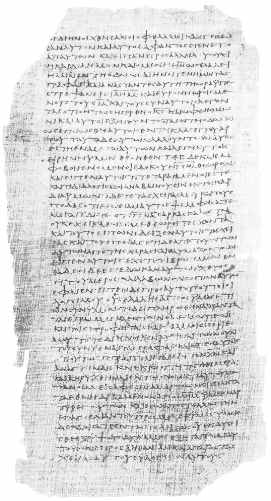
|
|
|
Photograph 5--
Luke 24:31-50 as preserved in Papyrus p75 from 200 A.D., including three post-resurrection appearances of Jesus. By permission of the Bodmer Library, Geneva. |
|
Translations Between 150 and 180 AD, translations of the New Testament were made into old Latin and Syriac, also called Aramaic. We do not have the originals of these. We have copies from the 4th and 5th centuries.
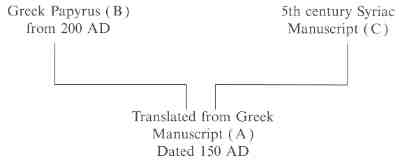
|
|
|
Diagram 4
|
|
At first it might seem that such late copies are of little value. However, if one looks at Diagram 4 and thinks about it for a moment, it becomes clear that where a 5th century Syriac manuscript (C) agrees with a Greek papyrus (B) from 200 AD, they are 2 witnesses giving a clear testimony as to what the Greek text (A) said at the time of translation in 150 AD.
Quotations from the Gospel-New Testament by Early Christian Writers
To give just one example of the testimony of the early Christian writers, I will mention Tertullian. He lived from 160-220 AD and was a presbyter of the Church in Carthage in North Africa. He quotes from the New Testament more than 7000 times, of which 3,800 are from the four Gospel accounts; and his quotations show that the text which he used is essentially the same as that which we have today.
Finally, although it is outside of the 2nd century, I shall refer again to the Codex Vaticanus which we saw in Photograph 3 in Part C of this chapter, and the Codex Sinaiticus. They both date from about 350 AD, only a little after the beginning of monasticism when the Qur'an testifies in the Sura of the Iron (Al-add) 57:27 that there were true Christians in the world. Photograph 6 shows a picture of the first Chapter of the Gospel according to John. These Codices are used to translate those parts of our present Gospel-New Testament which are missing from the earlier papyrus manuscripts mentioned above. Obviously they contain the Doctrinal Gospel.
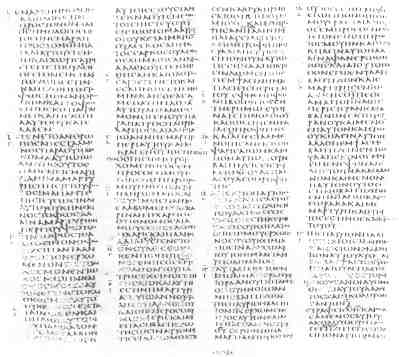
|
|
|
Photograph 6--
Codex Sinaiticus from 350 A.D. Includes John 1:14, "The 'Logos' (Word) became flesh and dwelt among us". By permission of the British Library. |
|
In summary, we can say that by the year 200 AD, the Gospel of Jesus the Messiah which we have today, was known over the whole Roman Empire. In order to clearly set forth this historical development we shall show it in the form of a diagram just as we did with the Qur'an.
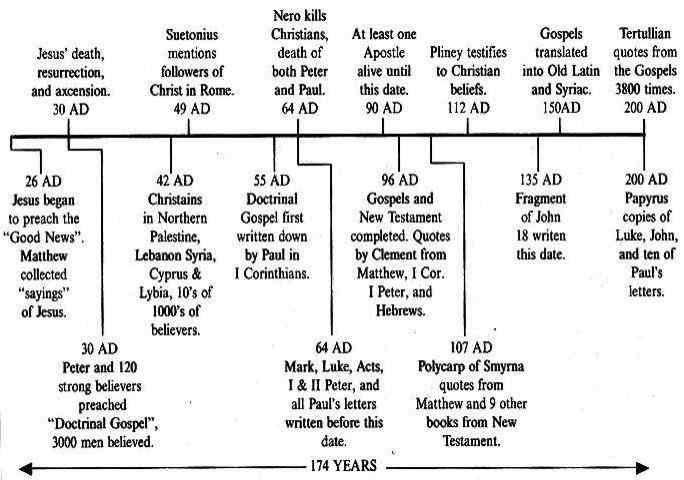
|
|
|
Diagram 5--
THE HISTORICAL DEVELOPMENT OF THE GOSPEL |
|
But this time we will answer with some other questions. "When could it have been changed?" Would the disciples of Jesus have changed it while they were alive until 90 or 95 AD? No Christian believer can accept this. No Muslim would accept it about Abu Bakr and Omar. And even if the last page of the Gospel according to Mark did get lost, the TOMB IS EMPTY! and the post-resurrection appearances of Jesus to his disciples are well described in the other three Gospel accounts.
Was the Gospel changed between 90 and 150 AD? There were now 10's of thousands and perhaps 100's of thousands of believers spread over the whole Roman world. Hundreds, even thousands of these believers had heard the Gospel message from Jesus' own disciples. Could it really have been altered in any fundamental point during this period? That would be impossible.
Was it changed between 150 and 200 AD? There are translations, quotations, and important papyrus copies from this period, all testifying to essentially the same text and containing the same Doctrinal Gospel. Therefore, in view of all these witnesses, WE CHRISTIANS BELIEVE that the Gospel-New Testament is the same now as it always was.
The reader will see that I have not attempted a comparable section on the Qur'an, a section covering the years between Othman's copy in 27 AH and the oldest Qur'an of 150 AH. I think that it could be done, but I am leaving that to my readers for their own personal investigation.
However, I do think that it will be helpful at this point if we compare the development of the Qur'an and the Gospel on the same time scale. The year when Muhammad and Jesus began to preach will be called "zero". In this way any similarities or differences will be easy to see.
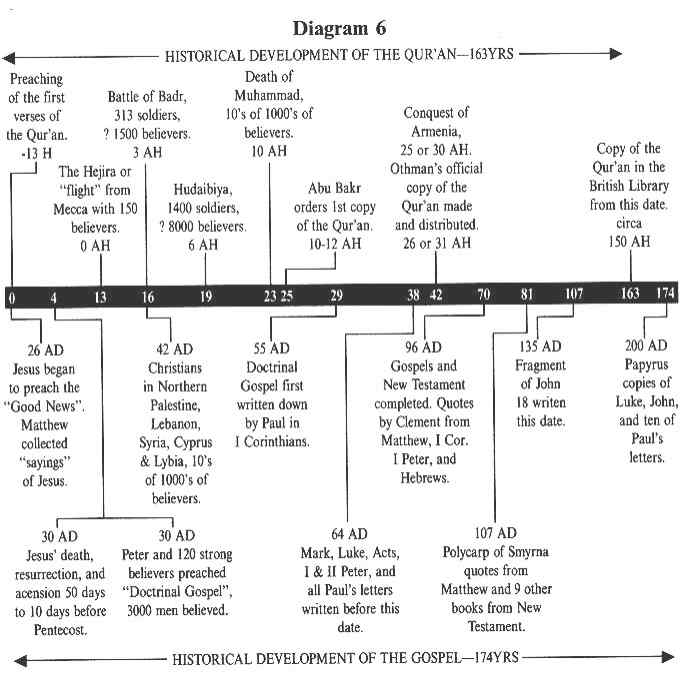
|
|
| Diagram 6 | |
Careful examination of Diagram 6 reveals some differences. For example, the number of Christians increased at a faster rate in the beginning---3000 believers on the first day of preaching.
What strikes one, though, are the similarities. If we compare the Hejira with Jesus' ascension to heaven, we find that there were 150 strong believers with Muhammad when he went to Medina; and Jesus left 120 strong believers when he ascended.
When we look at the situation after 10 more years we find that there were 10's of 1000's of Muslims when Muhammad died and his helpers became responsible. Similarly after Jesus' disciples had preached for ten years there were 10's of 1000's of Christians.
The spread of the Qur'an was almost completely oral until Othman sent around the official copies 42 years after Muhammad preached the first verses. The spread of Christianity was almost completely oral until 30 to 50 years after Jesus began preaching, by which time all of the New Testament had been written except some of John's writings.
Finally, the date of the oldest known complete Qur'an, approximately 163 yrs after Muhammad began preaching is essentially the same as the 174 years between the time that Jesus started preaching and our oldest papyrus copies of the Gospel accounts and other New Testament books.
As you BELIEVE that Zaid and Othman gathered the Qur'an carefully, we BELIEVE that Luke and John preserved the Gospel carefully.
As you BELIEVE that those who copied the Qur'an did it carefully, we BELIEVE that the scribes who copied the Gospel-New Testament did it carefully.
As you BELIEVE that those leading Muslims of the first century of the Hejira would not spend their money and their lives for something that they knew to be a lie, we also BELIEVE that Jesus' disciples---the Apostles---would not die, as Peter and Paul did, for something that they knew was a lie.
As you BELIEVE that the evidence is so great in favor of the reliable transmission of the Qur'an that you ARE SURE that you can use it with complete confidence, we BELIEVE that the above evidence is so great in favor of the reliable transmission of the Gospel that we ARE SURE that we can use it with complete confidence.
NEITHER THE PRESENT QUR'AN, NOR THE PRESENT GOSPEL ACCOUNTS HAVE SUFFERED ANY IMPORTANT CHANGE. THEY ARE ESSENTIALLY AS THEY WERE WRITTEN.
Answering Islam Home Page